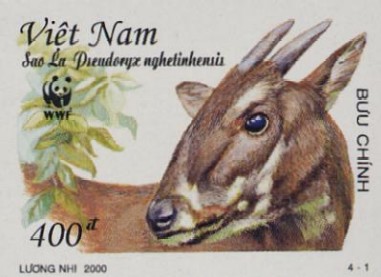
November 24, 2006

As opposed to viewing what recently happened during a formal anthropological criticism of cryptozoology as some cause for upset, let’s reframe what occurred as an opportunity for our field to broaden our worldview.
When the apparently charming Pamela D. McElwee, Ph. D., Assistant Professor, The School of Global Studies, Arizona State University (shown above), shared some insights, her audience may not have realized the significance of what she was saying. Certainly, however, cryptozoologists need to pay attention, as McElwee’s comment might be useful in reviewing some foundation thoughts within our field. If we wish to remain aware of how fast various possible cryptids’ habitats are changing, we must not get defensive but remain open-minded to the feedback of critics such as Dr. McElwee.
Anthropologist McElwee presented at last week’s meeting in San Jose, California, at the 105th annual meeting of the American Anthropological Association. Tulane University’s Jeb J. Card was in attendance and shared, in part, what he observed in these notes in his blog:
I noticed the following paper in the program, in a session entitled Disorder, Dangerous Terrains, Topics, and Critiques – Pamela D. McElwee (Arizona State University) "The Dangerous History of Cryptozoology: Curious Cases from Vietnam."
The paper addressed the way cryptzoologists have decided that Vietnam is a "lost world," a terra nullus within which we can imagine and dream. During the 1990s, as Vietnam opened up to the post-Cold War world, reports and then discoveries of large mammals and other species began to emerge from Vietnam. This attracted the attention of not just mainstream zoologists but cryptozoologists. They looked for somewhat more mundane game, such as the Kthing Vor cattle with twisted horns (there is debate on whether it actually exists or if the horns are created by humans as magical items) as well as for the more exotic Yehren-style wild men.
The paper was somewhat skeptical of the more extreme claims of cryptozoology, though more open-minded than one might expect. But the real takeaway message in regards to cryptozoology was that it is wrong to treat Vietnam as some kind of "lost world" or otherwise unknown place of mythical beasts, when it is actually an increasingly populated and urbanized region.
This in turn led to a spirited debate with a member of the audience, clearly a Bigfoot researcher. This individual (who I didn’t catch his name, but was at the meetings for the duration, not just for the individual session) took issue with some of the skepticism from the presenter and others at the session, and made it clear that he and his fellow researchers know much more about bigfoot genetics, society, and other issues than one would expect. I could tell, by the time the Minnesota Iceman was mentioned, that I was the only one in the symposium (besides perhaps presenter Dr. McElwee) who knew what this man was talking about.

The abstract of Dr. McElwee’s paper is available, and follows:
Cryptozoology is the search for and study of animals that are only rumored to exist. While perhaps most popularly associated with sightings of “Bigfoot” and the “Yeti”, in fact, cryptozoologists claim that their work is a science, and more importantly, that it is a combination of zoology and anthropology, as they often rely on local reports of animal sightings and use of local myths in identifying potentially new species. Vietnam has recently become a hotbed of cryptozoologic activity, and rumors of a wild ‘forest man’ in some remote areas of the country have prompted investigations by both Western and Vietnamese scientists. Additionally, a heated debate recently broke out in the pages of the journal Nature over the existence of a newly described species of cattle from Indochina, the khting vor. Cryptozoologists presented it as a new species to science while skeptics claim it is nothing more than a manipulated common cow. Thus, cryptozoology is a prime ‘critical intersection’ that raises uncomfortable questions about science and myth, culture and nature, and biology and anthropology. Are cryptozoologists scientists or kooks? How does cryptozoology different from seemingly more legitimate biodiversity studies seeking new descriptions of flora and fauna? What are the roles of anthropologists in reconciling local legends of mythical animals with those seeking sightings and scientific classification of these possibly fictional creatures? Based on fieldwork in Vietnam and readings of the cryptozoologic literature, the paper will address what cryptozoology tells us about the dangerous intersections between science, nature, and myth.
I will wait until I see the complete paper, but, of course, I do not see any “danger” in any intersections between nature, zoology, anthropology, cryptozoology, and hominology. Of couse, as everyone from 1940s’ “cryptozoology” founder Ivan T. Sanderson to 1950s’ “father of cryptozoology” Bernard Heuvelmans, from anthropologists who were my professors to anthropologists who today are my associates, from folklorists to skeptics, they all have spoken or written about the world of difference between myths and legends, the latter of which has more to do with folklore and a hint of precursor reality.
For those few here who are unaware of the Vietnamese "Lost World" (which was a term first used in the mass media, please note, not by cryptozoologists) that Dr. McElee is discussing, here is my summary of some of the defining moments, as given in two locations in my 1999 book, Cryptozoology A to Z:
^^^^^^^^^^^^^
In July 1992, global news organizations introduced everyone to the startling discovery of a so-called lost world of animals living in Vietnam’s Vu Quang Nature Reserve, a sixty-five-square-mile area near the Laotian border. The knowledge of the faunal diversity of Vietnam was impeded by years of war and limited international contact. Scientists have described the reserve as a "lost world seemingly untouched by the war," and possibly teeming with new species. The Vu Quang Reserve has one of the country’s richest and most pristine forests.
The first and most exciting animal discovery was a creature known locally as the saola ("forest goat"). While investigating scientists did not observe a living specimen, they did find three sets of upper skulls and horns. One of the skulls was from a recently deceased animal, enough to establish its existence and scientifically describe it. The saola or Vu Quang ox (Pseudoryx nghetinhensis) had been officially discovered Since it was a part of the area’s hunting lore, this discovery has significant implications for cryptozoology, meeting the essential requirement that a cryptozoological specimen be an animal familiar to natives but still "unknown to science" and a "hidden animal."
The June 3, 1993, issue of Nature makes it clear just how unique this animal is: "Pseudoryx differs significantly from all described genera in appearance, morphology, cranial and dental features and DNA. The long, smooth, almost straight, slender horns, elongated premolars, large face gland and distinctive colour pattern are diagnostic.” The pattern mentioned is a series of black and white markings on the face, neck, feet and rump.
It may be significant that the kouprey was found along the Mekong River in Cambodia-Laos, in the same general region of the Vu Quang ox. The Vu Quang ox, according to locals, inhabits the pristine evergreen montane forests of northern Vietnam, bordering Laos. Until the spring of 1994, Vietnamese and American biologists had not encountered a living specimen, though they had noted signs of 20 individual animals.
Finally, a female calf was captured just outside the Vu Quang Preserve and moved to an eight-acre, forested botanical garden preserve. The new detainee has a thin, dark brown stripe running down its back, distinctive white markings on its face, large eyes, and a short, fluffy tail. The saola is the largest land mammal to be discovered since the kouprey in 1937.
In March 1994 Vietnam’s lost world yielded up evidence of yet another genus: the giant muntjac, or barking deer. The largest muntjac ever found, this one has a red grizzled coat and weighs 90 to 100 pounds. Not long afterwards, the World Wildlife Fund reported the capture of a live specimen in Laos. Another new species of muntjak deer, Muntiacus trungsonensis, has been identified in scrub forest in the heavily war-damaged but dense scrub forest of Quang Tri.
The Lost World has produced several other recent discoveries, including evidence of a new species of fish, two previously unknown bird species, and an unknown tortoise with a striking yellow shell. Meanwhile, the search is on for a new reptile known as the burrowing Vietnamese sharp-nosed snake. During the Vietnam War, U.S. Navy officers gathered and photographed specimens of this snake, but the specimens were lost. A recent issue of Cryptozoology (dated 1992 but published in 1994) offers a scientific description of this reported, but so far unproved, animal.
In addition to these, Dr. Ha Dinh Duc of the National University of Hanoi reports that a colleague at Hue University has seen another goat-like animal near A Luoi in Thua Thien Province. Dr. Pham Nhat (Forestry University, Xuan Mai) reports two unusual civet (a catlike animal) specimens from Lao Cai Province in the far northwest.
In Vietnam, zoologists and biologists are discovering new animals at an amazing rate in what has become known as their very special Indochinese “lost world.” Needless to say, much credit must go to the Vietnamese researchers, specifically Dr. Do Tuoc, and their associate, Dr. John MacKinnon.
One thing is certain: the discoveries issuing from the Lost World of Vietnam seem far from over.
^^^^^^^^^^^^^
In 1999, I wrote the above (with some definitions added by the Simon and Schuster editors, of course, plus my phrase "World Wildlife Fund has discovered" replaced by their "The Lost World has produced"). Since 2000, more discoveries have occurred in this corner of the world. Still, should we be concerned by the new insights from Dr. McElwee? What post-war urbanization impacts are hurting new animals in the formerly rather pristine rainforests? Besides renewing some of my Vietnamese contacts to ask them their view, I look forward to reading Dr. McElwee’s paper, to see how her cryptozoology critique might call for a revision of the use of the phrase "lost world" or not.
About Loren Coleman
Loren Coleman is one of the world’s leading cryptozoologists, some say “the” leading living cryptozoologist. Certainly, he is acknowledged as the current living American researcher and writer who has most popularized cryptozoology in the late 20th and early 21st centuries.
Starting his fieldwork and investigations in 1960, after traveling and trekking extensively in pursuit of cryptozoological mysteries, Coleman began writing to share his experiences in 1969. An honorary member of Ivan T. Sanderson’s Society for the Investigation of the Unexplained in the 1970s, Coleman has been bestowed with similar honorary memberships of the North Idaho College Cryptozoology Club in 1983, and in subsequent years, that of the British Columbia Scientific Cryptozoology Club, CryptoSafari International, and other international organizations. He was also a Life Member and Benefactor of the International Society of Cryptozoology (now-defunct).
Loren Coleman’s daily blog, as a member of the Cryptomundo Team, served as an ongoing avenue of communication for the ever-growing body of cryptozoo news from 2005 through 2013. He returned as an infrequent contributor beginning Halloween week of 2015.
Coleman is the founder in 2003, and current director of the International Cryptozoology Museum in Portland, Maine.
Filed under Breaking News, Cryptomundo Exclusive, Cryptotourism, CryptoZoo News, Cryptozoologists, Cryptozoology, Evidence, Expedition Reports, Forensic Science, New Species, Pop Culture, Public Forum, Reviews